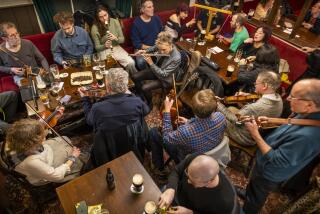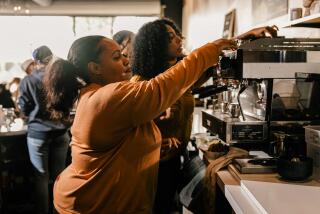A spot of tea and British history
I spent a great deal of time at St. Martin-in-the-Fields Church on a recent trip to London. But I wasn’t praying.
I had tea in the church’s dramatic 18th century Cafe-in-the-Crypt. I took in a free lunchtime concert and a candlelit nighttime performance. And I browsed endlessly in the gift shop, art gallery, and covered crafts market in the courtyard.
Where else can a visitor find such an outstanding array of cultural and commercial attractions in a house of worship? This church, with its elegant, soaring steeple and massive Corinthian portico, is set squarely in the West End theater district across from Trafalgar Square and is one of London’s most storied and prestigious. Designed by Scottish architect James Gibbs, the current building was constructed from 1721 to 1726, and its unique Greek and Roman style became the prototype for Anglican churches in England and for Colonial churches in America.
It took only one visit to realize why St. Martin’s is among Britain’s 10 most-visited churches. Beyond its stark beauty and imposing grandeur, the church is a social waystation for much of London. Thousands of parishioners fill its pews for 27 Anglican services weekly. Others come for the sophisticated food in its award-winning cafe. And others are drawn to the ongoing program of concerts and recitals — about 350 a year — all befitting the talent and professionalism of the city’s best theaters nearby.
When I wasn’t eating, listening or endlessly gazing, I found myself browsing in St. Martin’s cozy gift shop. Its shelves bulge with clever, unique or delicious enticements. The range includes the church’s own label of jam, chutney, tea and biscuits; a large selection of Celtic crosses; handcrafted heather-gem jewelry from Scotland; and CDs featuring classical music conducted by Neville Mariner, founder of the Academy of St. Martin-in-the-Fields.
Enamored with the diversity, I returned frequently to St. Martin’s. History and tradition are part of its attraction. In the early 1200s, St. Martin-in- the-Fields was exactly that, a church in the fields. Monks who tended vegetable crops in what is now Covent Garden used it as a chapel and oratory.
Kings and queens
DURING an hourlong guided tour, I learned the church was named after a Roman soldier who slashed his cloak down the center with his sword and gave half to a cold, barely clothed beggar. In a dream that night, the soldier had a vision that the beggar was Jesus Christ; the next morning his cloak was whole again. Martin quickly converted to Christianity and became a monk, priest and, in 371, the Bishop of Tours in France.St. Martin’s was rebuilt and enlarged three times. Henry VIII ordered the first reconstruction in 1542-43 to accommodate the larger populace attending St. Martin’s as the Church of England, formed after Henry rejected papal authority and divorced his first wife. A second reason for this rebuilding was that Henry and his second wife, Anne Boleyn (1507-36), were concerned about infection from the many plague-victim corpses being carried through the palace buildings at Whitehall on the way to burial at St. Margaret’s. Henry’s solution was to extend the boundaries of St. Martin’s to include more parishioners — possible plague victims — who would ultimately be buried there instead of at St. Margaret’s.
The 1607 rebuilding and enlargement, under James I, was necessary to hold the ever-burgeoning population and improve the structural quality of the building. From 1721 to ‘26, the present St. Martin’s was constructed for similar reasons. King George I, who reigned from 1714 to 1727, was the first churchwarden. His colorful coat of arms looms high on the ceiling in front of the altar.
Our guide unlocked a door on the church’s upper gallery and led us through the royal box. He raised a glass window on its front, explaining the king had it installed so he could close it if the sermon bored him.
In World War I, the church was used as a shelter for soldiers passing through nearby Charing Cross Station and, during the Blitz of World War II, 1,000 people often slept on bunkbeds in the crypt. As we gazed at the vast, clear windows shimmering in the sunlight, our guide noted that they had replaced the colorful Victorian stained glass that was shattered by a nearby bombing in 1940.
Because Buckingham Palace and St. James’s Palace are within its boundaries, St. Martin’s is the royal parish church. Queen Mary, wife of George V, often attended services here, and the recently deceased Queen Mum was a regular visitor. When her daughters, Princesses Elizabeth (the current queen) and Margaret, were young girls, the three attended St. Martin’s Christmas pageants and Nativity plays. The Queen Mother later became a royal patron of the church, raising money for its maintenance and charities.
The crypt of St. Martin’s is now a rustically elegant cafe. The restaurant’s dark-red and brown brickwork complement a vaulted ceiling. The floors are dark stone slabs; some are burial tablets from the church’s old cemetery, creating an effect eerie and ethereal.
In this softly illuminated space is a buffet-style cafe that seats 170. The day begins quietly with coffee and pastries served at 10 a.m., or noon on Sundays.
As students munch banana muffins and white-haired parishioners chat over coffee, tourists scan the London Walks tour company leaflets and theater brochures stacked on a table near the door.
Lunchtime (11:30 a.m. to 3 p.m.) is a different scene. The crowd is more eclectic: a bohemian mix of actors and artists amid shoppers, local professionals, foodies and tourists. The pace is more hurried and the menu more extensive, though prices still are reasonable.
As my husband, Dick, and I grabbed trays and made our way down the buffet line, we encountered a focaccia sandwich platter heaped with choices: honey-roasted ham and Swiss cheese, $6.50; sliced salmon with lettuce and cucumber, $6.50; cheddar cheese, lettuce, tomato and pickle, $6. Hot dishes included turkey escalope in a red wine and bacon sauce, with potatoes and vegetables, for $11.Tea is offered from 3 to 5 p.m., with single pots for $1.85 — as good as it gets in central London. The water is steaming hot, the strong black tea soothing and invigorating. Other hot-drink prices seemed lower than those at many cafes and chains in London, and the quality as good, if not better.
A tempting array of tea-time delights — many of them baked here — is available. The most popular is the cafe’s specialty, and Dick’s favorite, a bowl of warm homemade bread-and-butter pudding drenched with hot vanilla custard sauce, a feast for body and soul at $5.50. My own favorite indulgence was the delicate crème brûlée for $5. The cafe bakes its own scones; the price is a modest $4 with a pot of tea.
Dinner is offered from 5:30 to 8 p.m., or until 11 p.m. from Thursdays to Saturdays, when there are concerts. The early hour, homemade food and West End location make it a good spot for a pre-theater dinner or snack.
Some outstanding hot entrees are tender roasted poussin (small chickens) with a honey, mustard and rosemary glaze, served with new potatoes and two sides of vegetables, $12.50; or succulent roast leg of lamb with tomato-mint sauce, mashed potatoes and peas, $11. Every time I dine at the cafe, I reach for the classic roasted chicken with mashed potatoes and sides of carrots and peas for $12.50. (Think Sunday dinner at Grandma’s.)
A lively selection of bottled beers and wines is also served.
Two of the most soothing hours of my vacation were the free lunchtime concerts I attended at St. Martin’s. These hourlong respites have been a tradition for more than 50 years. They’re offered at 1:05 p.m. on Mondays, Tuesdays and Fridays, and performed by college-student musicians.
So there I was, in the urgent clatter of central London, enthralled by the lyrical sounds coming from a piano played by a dashing German student in a black tuxedo.
On another afternoon, amid the church’s massive white Corinthian columns, about 150 of us were lulled by classical and operatic songs from five of the church’s choral scholars. Piano accompaniment was provided by St. Martin’s director of music, Nicholas Danks, who oversees the organ music, choir recitals and choral activity featured at services.
The tempo was stepped up considerably during a free concert by the Jazzberries one evening in the dimly lighted cafe.
We joined a standing-room-only crowd of 200 for roast parsnip and ginger soup with thick slices of crusty homemade bread ($6) and a hearty lamb and root vegetable casserole ($12.50). For two relaxing hours, we listened to four young men on instruments and a sultry-voiced female vocalist.
A week later, we treated ourselves to a two-hour candlelit concert in the church. The formally attired, 14-member Belmont Ensemble filled St. Martin’s with the exquisite sounds of two Mozart symphonies (No. 29 in A and Salzburg Symphony No. 2) and three pieces by Handel, including Water Music Suite and Overture Giulio Cesare. The candlelight brought out the Italian carved cherubs, scrolls and floral crests on the church’s paneled ceilings.
The cultural and commercial activities at St. Martin’s are complemented by its commitment to spiritual and social issues. The seven Sunday services include two in Chinese to accommodate the many worshipers from nearby Chinatown. St. Martin’s operates a homeless shelter, and 7,000 people go through its Social Care Unit each year.
St. Martin-in-the-Fields is a unique blend of Middle Ages chivalry and modern urban flair. When I walk down Charing Cross Road in the hectic West End and see it looming around the curve — huge, simple, majestic — I think of it as a sanctuary, a church in the fields.
*
(BEGIN TEXT OF INFOBOX)
St. Martin’s, scones
GETTING THERE:
From LAX, nonstop flights are available to London on British Airways, Air New Zealand, Virgin Atlantic, American and United. Connecting flights (change of planes) are available on Northwest, Continental, Delta, US Airways. Restricted round-trip fares begin at $508 until May 30, then rise to $778 until Sept. 1.
WHAT AND WHERE:
St. Martin-in-the-Fields, Trafalgar Square, London WC2N 4JJ; 011-44-20-7766-1100, https://www.stmartin-in-the-fields.org . Tube stops: Embankment, Charing Cross Road.
Hours for Cafe-in-the-Crypt: Sundays, noon-8 p.m.; Mondays-Wednesdays, 10 a.m.-8 p.m.; Thursdays-Saturdays, 10 a.m.-11 p.m.
TO LEARN MORE:
Visit Britain, (800) GO-2-BRITAIN (462-2748), https://www.visitbritain.org .
— Irene Woodbury
More to Read
Sign up for The Wild
We’ll help you find the best places to hike, bike and run, as well as the perfect silent spots for meditation and yoga.
You may occasionally receive promotional content from the Los Angeles Times.






